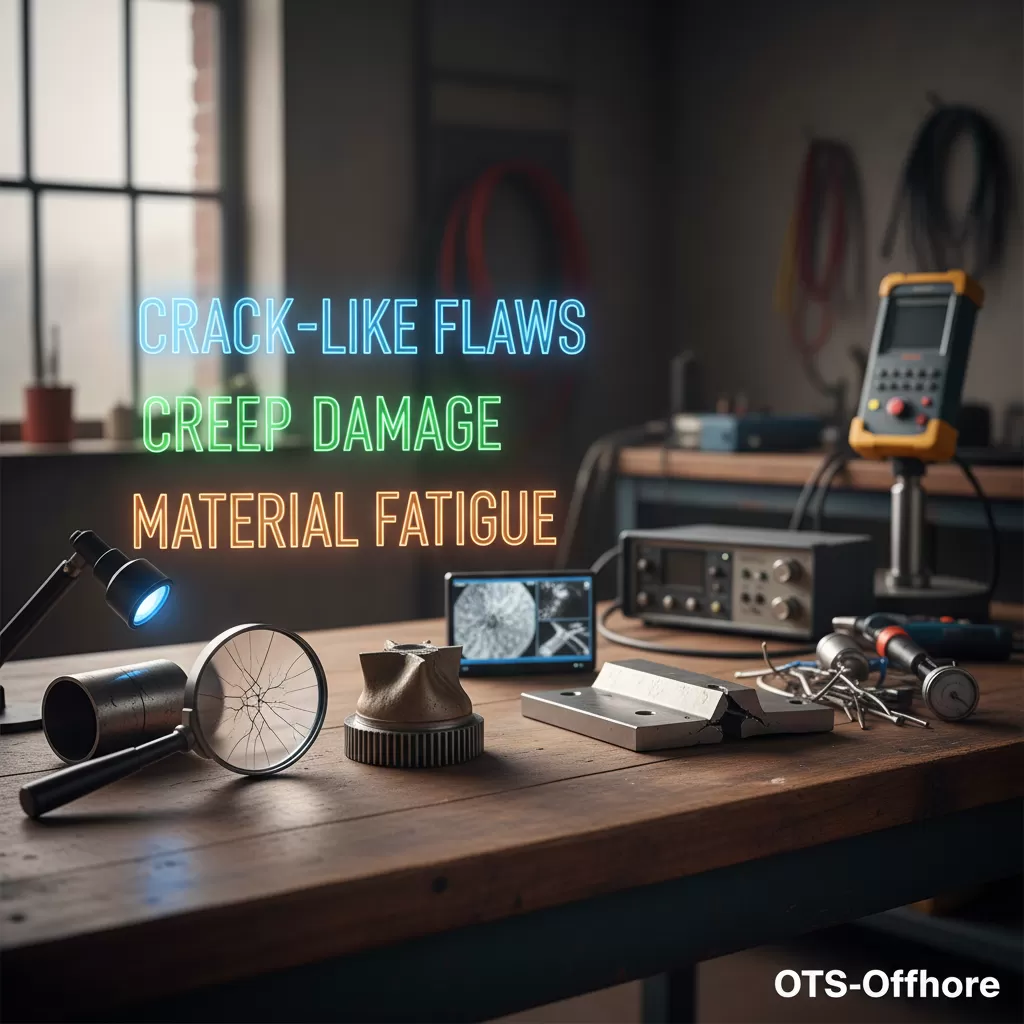Types Defects NDT: encompasses critical aspects of material integrity assessment in the oil and gas and energy sectors. This comprehensive overview delves into two prevalent categories of flaws: crack-like discontinuities and creep damage, examining their origins, detection methodologies, and implications for structural reliability. Understanding these defect types is paramount for ensuring the safety, efficiency, and longevity of critical infrastructure.
Understanding Types Defects NDT: Crack-like Flaws and Creep Damage
The integrity of critical components within the oil and gas and broader energy industries hinges on the meticulous application of Non-Destructive Testing (NDT) methods. These sophisticated techniques are indispensable for identifying and characterizing various types of defects that can compromise structural soundness and operational safety. Among the most significant and frequently encountered types of defects NDT scrutinizes are crack-like flaws and creep damage. These flaw categories represent distinct mechanisms of material degradation, each with unique formation pathways, visual characteristics, and NDT detection challenges. A thorough comprehension of these types of defects NDT is not merely academic; it directly translates into enhanced risk management, optimized maintenance strategies, and the prevention of catastrophic failures. The relentless pursuit of asset integrity demands a deep dive into the nuances of these defect manifestations.
The Pervasive Nature of Crack-like Flaws in Energy Infrastructure
Crack-like flaws, a fundamental concern in Types Defects NDT, represent planar discontinuities within a material that exhibit a high aspect ratio (length significantly greater than width). These defects can originate from a multitude of sources, each contributing to the initiation and propagation of potentially hazardous cracks. Understanding these origins is key to implementing effective preventative measures and selecting appropriate NDT techniques. The ramifications of unchecked crack-like flaws can range from minor leaks to catastrophic structural collapse, underscoring their critical importance in asset integrity management.
Fatigue Cracking: The Silent Corroder
Fatigue cracking is a prevalent mechanism for crack initiation, particularly in components subjected to cyclic loading. These loads can be induced by pressure fluctuations, mechanical vibrations, thermal cycling, or operational stresses. Under repeated stress cycles, even stresses below the material’s yield strength can initiate microscopic cracks at stress concentration points, such as surface imperfections, sharp corners, or weld defects. As the cyclic loading continues, these micro-cracks propagate, coalescing to form larger, observable flaws. The fracture surface of a fatigue crack often exhibits characteristic “beach marks” or striations, indicative of incremental crack growth during each stress cycle. Detecting early-stage fatigue cracks, before they reach critical lengths, is a primary objective of NDT inspections. Techniques like dye penetrant testing (PT), magnetic particle testing (MT), eddy current testing (ECT), and ultrasonic testing (UT) are instrumental in identifying these insidious defects.
Stress Corrosion Cracking (SCC): A Synergistic Assault
Stress Corrosion Cracking (SCC) is a complex phenomenon that arises from the combined action of tensile stress and a specific corrosive environment. Unlike general corrosion, SCC can lead to rapid crack propagation even in materials that exhibit good overall corrosion resistance. The mechanism involves the interaction between the material and its surrounding corrosive medium, leading to localized electrochemical reactions that promote crack initiation and growth. The specific corrosive species and the material’s susceptibility vary widely, making SCC a challenging defect to predict and manage. For instance, in pipelines, certain environments can induce SCC, leading to through-wall cracks that pose significant leakage risks. Similarly, in high-temperature steam environments, specific alloys can be susceptible to SCC. NDT methods play a crucial role in detecting the surface and subsurface indications of SCC. Visual inspection, eddy current testing, and ultrasonic testing are commonly employed, often requiring specialized scanning techniques to cover complex geometries and identify the characteristic crack morphology.
Hydrogen-Induced Cracking (HIC) and Sulfide Stress Cracking (SSC): The Hydrogen Menace
Hydrogen-induced cracking (HIC) and sulfide stress cracking (SSC) are critical concerns in environments where hydrogen is present, particularly in sour service conditions prevalent in the oil and gas industry (i.e., environments containing hydrogen sulfide, H2S). HIC refers to the internal cracking and blistering of steel due to the absorption of atomic hydrogen. This hydrogen can originate from the corrosion process itself or from external sources. The atomic hydrogen diffuses into the steel and recombines into molecular hydrogen at internal voids, creating high internal pressures that lead to crack formation. SSC, on the other hand, is a form of stress corrosion cracking where the presence of H2S in a corrosive environment, combined with applied tensile stress, leads to brittle fracture. SSC is particularly insidious as it can occur at stresses below the material’s yield strength. NDT methods for detecting these hydrogen-related cracking phenomena include ultrasonic testing, which can identify internal laminations and cracks, and potentially eddy current testing for surface indications. Proper material selection and process control are crucial preventative measures against HIC and SSC.
Other Crack-like Flaws: A Broad Spectrum
Beyond the aforementioned categories, numerous other mechanisms can lead to crack-like defects. These include weld defects such as lack of fusion, incomplete penetration, and slag inclusions, which can act as stress raisers and initiate cracks. Grinding marks and machining defects can also introduce surface discontinuities that promote crack initiation. Thermal cracking, resulting from rapid heating and cooling cycles during welding or operational upsets, is another significant contributor. The diverse origins of crack-like flaws necessitate a comprehensive approach to NDT, employing a suite of techniques tailored to the specific material, geometry, and suspected defect type. The vigilant application of Types Defects NDT is essential for preempting failures.

Creep Damage: The Slow Erosion of Material Strength
Creep damage, a critical aspect of Types Defects NDT, refers to the time-dependent deformation and eventual fracture of materials under sustained stress at elevated temperatures. While materials are generally designed to withstand stresses well below their yield strength at ambient temperatures, their behavior changes dramatically at higher temperatures. Even relatively low stresses, applied over extended periods at elevated temperatures, can cause permanent deformation and microstructural degradation, leading to creep damage. This phenomenon is particularly relevant in high-temperature service environments common in power generation (e.g., steam turbines, boilers) and petrochemical processing (e.g., furnaces, reactors).
The Mechanism of Creep Deformation
Creep deformation occurs through several micro-mechanical mechanisms, primarily diffusion and dislocation movement. At moderate temperatures, diffusion creep dominates, where atoms move through the crystal lattice to relieve stress. At higher temperatures, dislocation creep becomes more significant, involving the movement and multiplication of dislocations within the material. This movement leads to macroscopic deformation. Over time, these processes can lead to the formation of internal voids and micro-cracks, particularly at grain boundaries. These micro-voids can coalesce, forming larger cracks that eventually link up, leading to creep rupture. The rate of creep is highly dependent on temperature, stress, and the material’s inherent properties. Understanding these dependencies is crucial for predicting the remaining life of components subjected to creep conditions.
Microstructural Changes Associated with Creep Damage
Creep damage is intrinsically linked to observable microstructural changes. As creep progresses, grain boundaries can become weakened, leading to intergranular cracking. The formation of cavities and voids within the grains and at grain boundaries is a hallmark of creep damage. These voids reduce the effective cross-sectional area of the material and act as stress concentrators, accelerating crack growth. In some cases, materials may also undergo microstructural coarsening or precipitation changes that can affect their creep resistance. Detecting these subtle microstructural alterations before significant macroscopic damage occurs is a key challenge for NDT professionals. Advanced ultrasonic techniques, such as phased array UT, and advanced radiographic methods are being explored for their potential in characterizing creep damage. However, often, the primary indicators are macroscopic deformation and eventual failure, highlighting the importance of regular inspections and predictive modeling.
Detecting and Assessing Creep Damage: NDT Challenges and Approaches
Detecting and quantifying creep damage presents unique challenges for NDT. Unlike sharp cracks, creep damage often manifests as diffuse internal damage, void formation, and subtle changes in material properties. Traditional surface-based NDT methods may not be sufficient to detect internal creep cavitation. Ultrasonic testing is often the primary NDT method employed for assessing creep damage. Changes in ultrasonic wave velocity, attenuation, and backscatter can indicate the presence of creep voids. Advanced UT techniques, such as ultrasonic backscatter measurement and acoustic emission monitoring, are showing promise in providing more sensitive detection of creep damage. However, interpreting the results can be complex, and often requires correlation with other inspection data and material knowledge. Visual inspection for signs of bulging, distortion, or surface creep marks is also a crucial first step. In some instances, replication metallography, a form of surface replication followed by microscopic examination, can be used to assess grain boundary cavitation. The ongoing development of more sensitive and advanced NDT methods is critical for improving the assessment of creep damage in high-temperature service components. The accurate identification of Types Defects NDT, including creep damage, is an ongoing area of research and development.
Integrated NDT Strategies for Comprehensive Asset Integrity
Given the distinct characteristics and origins of crack-like flaws and creep damage, a singular NDT method is rarely sufficient for comprehensive asset integrity assessment. An integrated NDT strategy, employing a combination of techniques, is essential for effectively identifying, characterizing, and managing these diverse types of defects NDT. The selection of appropriate NDT methods depends on numerous factors, including the material of construction, operating environment, service temperature, expected defect types, component geometry, and regulatory requirements. For instance, in a high-pressure pipeline susceptible to both fatigue cracking and SCC, a combination of visual inspection, eddy current testing for surface indications, and ultrasonic testing for volumetric flaws would be a prudent approach.
Synergistic Application of NDT Techniques
The synergy between different NDT methods provides a more robust and reliable assessment of component health. For example, visual inspection can identify gross surface anomalies that may warrant closer examination with more sensitive techniques like PT or MT. UT, with its ability to penetrate materials and detect internal flaws, is invaluable for identifying subsurface cracks and, to some extent, creep damage. ECT excels at detecting surface and near-surface flaws, particularly in conductive materials, and can be sensitive to the tight, planar nature of cracks. Radiographic testing (RT) can be used to detect internal volumetric flaws, though its sensitivity to very fine cracks can be limited. Combining the strengths of these various techniques allows for a more complete picture of the defect landscape within a component. The effective management of Types Defects NDT relies heavily on this synergistic approach.
The Role of Advanced NDT and Emerging Technologies
The field of NDT is continually evolving with the development of advanced techniques and emerging technologies. Phased array ultrasonic testing (PAUT) offers enhanced imaging capabilities and the ability to steer ultrasonic beams, allowing for more accurate flaw sizing and characterization, particularly for complex geometries and crack-like flaws. Time-of-flight diffraction (TOFD) is another advanced UT technique highly effective for sizing cracks. Eddy current array (ECA) technology provides faster surface inspection coverage and improved defect detection. Guided wave ultrasonics can inspect long lengths of pipe or structures from a single access point, making it valuable for inspecting pipelines and risers. Furthermore, technologies such as computed radiography (CR) and digital radiography (DR) offer improved image quality and efficiency compared to conventional film radiography. The exploration of non-conventional NDT methods, such as acoustic emission (AE) for detecting crack growth in real-time and pulsed eddy current (PEC) for inspecting through insulation, continues to expand the NDT toolkit for addressing various types of defects NDT.
Tham khảo thêm: Thông tin chi tiết về Types Defects NDT: trên Wikipedia.
The accurate and timely identification of Types Defects NDT, specifically crack-like flaws and creep damage, is a cornerstone of asset integrity management in the oil, gas, and energy sectors. Crack-like flaws, stemming from fatigue, stress corrosion, hydrogen embrittlement, and welding imperfections, pose immediate risks of leakage and structural failure. Creep damage, a consequence of sustained stress at elevated temperatures, represents a gradual degradation of material properties leading to deformation and eventual fracture. An integrated NDT approach, leveraging the strengths of various conventional and advanced techniques, is paramount for effectively detecting, characterizing, and mitigating these critical defect types. Continuous innovation in NDT technologies is vital for enhancing inspection reliability, optimizing maintenance schedules, and ultimately ensuring the safety and longevity of energy infrastructure.








